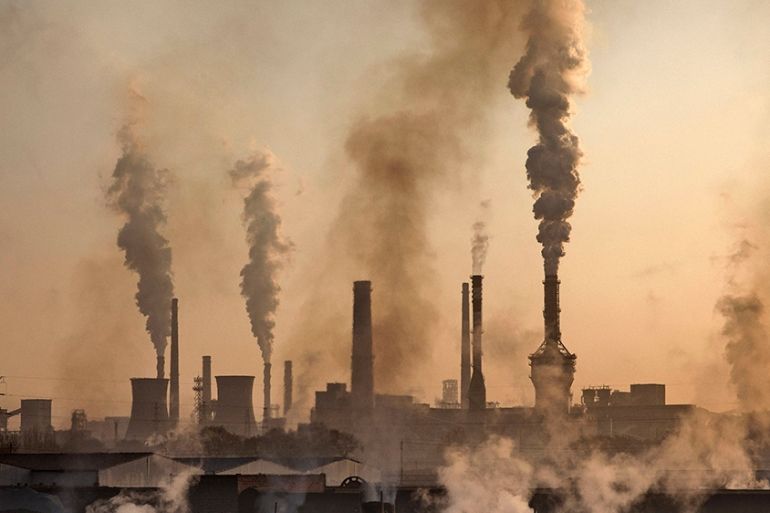As most countries cut back on coal, China is burning more of it
Studies show that fossil fuel-burning countries led by China and the US are set to exceed 2030 climate targets.

As most of the world reduces its reliance on environmentally harmful coal for its energy needs, a new study published on Wednesday says one country is burning more of it than ever: China.
It raised its coal-fired power capacity by 42.9 gigawatts (GW), or about 4.5 percent, in the 18 months to June, connecting new projects to its grid, according to United States-based research network Global Energy Monitor.
Keep reading
list of 3 itemsEIB to cease funding fossil fuel projects by 2021
China plans the most new coal power projects globally
It also has nearly enough coal-fired plants being built to power the whole of France. China has 121.3GW worth of plants under construction, the report says.
The increase in capacity follows a 2014-16 surge in approvals by local governments aiming to boost growth while formerly suspended projects have also been restarted, the report said.
In the rest of the world, coal-fired power capacity fell by 8.1GW over the same period.
To cut pollution and greenhouse gas emissions, China has promised an “energy revolution” aimed at dramatically reducing its reliance on coal. It cut coal’s share of the country’s total energy from 68 percent in 2012 to 59 percent last year, and researchers predict it will fall to 55.3 percent by 2020.
Absolute coal consumption, however, has continued to increase in line with a rise in China’s energy demands.
Environmental groups have accused Beijing of relaxing its efforts to reduce its reliance on coal, pointing to remarks in October by Premier Li Keqiang, who urged China to make greater use of its coal “endowment” by building clean power plants.
China approved 40 new coal mines in the first three quarters of 2019, and it has continued to make use of “green” financing to support coal-related projects.
China’s total coal-fired power capacity stands at more than 1,000GW. Global Energy Monitor said it needed to close more than 40 percent of that to meet greenhouse gas reductions required to keep global temperature rises to less than 2 degrees Celsius (3.6 degrees Fahrenheit) above pre-industrial levels.
It urged the Chinese government to strengthen policies discouraging coal plants, support low-carbon power and move towards clean energy, while an investor body warned of the risk of building new coal-fired plants.
“Over 40 percent of China’s existing coal fleet is already estimated to be lossmaking,” said Stephanie Pfeifer, chief executive of the Institutional Investors Group on Climate Change.
Though costs are now as low as fossil fuels, some Chinese policymakers worry that renewable sources like wind and solar are unreliable, and there are concerns that decarbonisation will hurt the country’s coal regions.
Some also believe that future energy shortages could hurt China’s attempts to address its slowing economy, said Yang Fuqiang, a senior adviser with the Natural Resources Defense Council, a US environment group.
“Right now there is a big argument about whether China needs more coal-fired power or not,” he told Reuters news agency. “They think the 14th five-year plan (2021-25) will stimulate economic development and they are a little afraid there won’t be enough electricity to support the economy.”
Missing targets
Meanwhile, another new study published on Wednesday, this one by the United Nations and various research groups, says China is one of the world’s 10 major fossil fuel producers that are set to exceed global environmental goals with excessive coal, oil and gas extraction in the next decade.
In its latest warning on climate change, the UN-led study revealed that these countries plan to produce between 50 percent and 120 percent more fossil fuels than the Paris Agreement targets by 2030.
Other countries analysed included the United States, Russia, India, Australia, Indonesia, Canada, Germany, Norway and the United Kingdom.
“The world’s energy supply remains dominated by coal, oil and gas, driving emission levels that are inconsistent with climate goals,” said UN Environment Programme (UNEP) executive director Inger Andersen.
As well as the UNEP, the report was produced by the Stockholm Environment Institute, the International Institute for Sustainable Development, the Overseas Development Institute, and the Centre for International Climate and Environmental Research and Climate Analytics (CICERO).
The group created a new metric called “the fossil fuel production gap” highlighting the difference between rising production and the decline needed to restrict global warming.
The gap was largest for coal, with countries planning to produce 150 percent more in 2030 than would be consistent with limiting warming to 2C (3.6F), and 280 percent more than would limit warming to 1.5C (2.7F).
“The continued expansion of fossil fuel production – and the widening of the global production gap – is underpinned by a combination of ambitious national plans, government subsidies to producers, and other forms of public finance,” the report said.
The report precedes the UNEP’s annual “emissions gap” report, due next week, which assesses whether countries’ emissions reduction policies are tough enough.